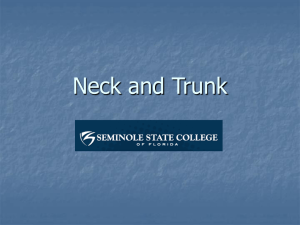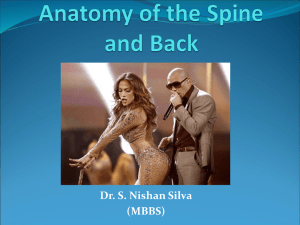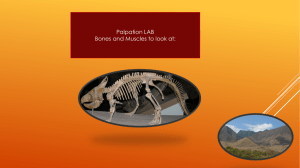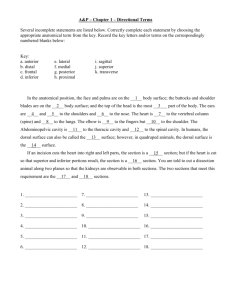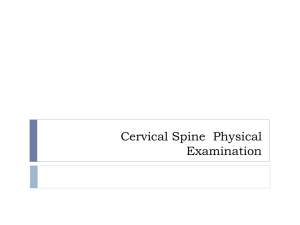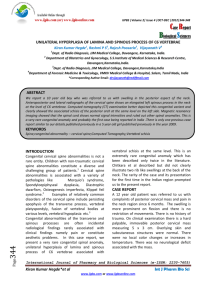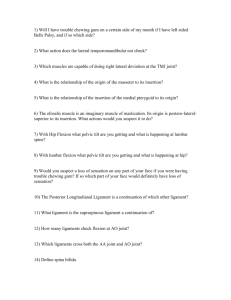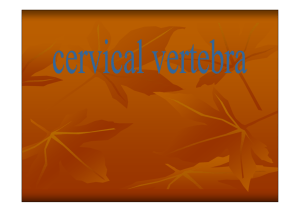File
advertisement
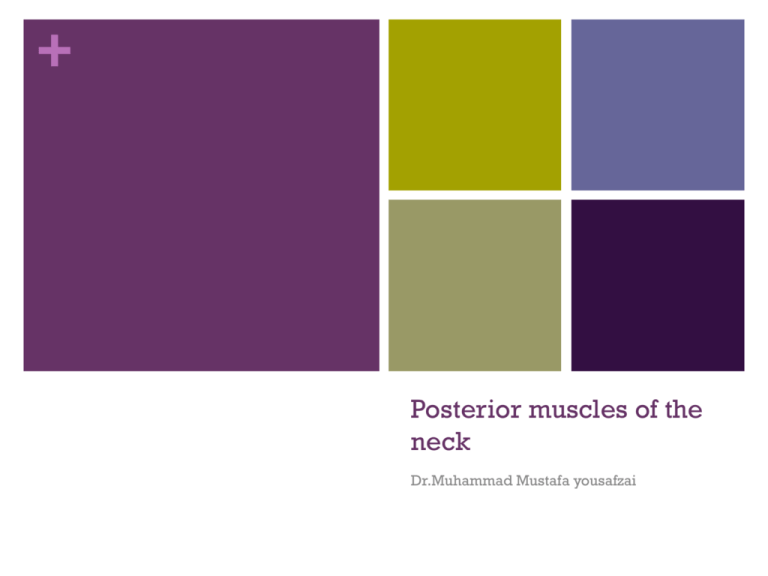
+ Posterior muscles of the neck Dr.Muhammad Mustafa yousafzai + Different goups of muscles of back Superficial Inter mediate Spinotransversales Erector spinae Transversospinales Segmental back muscles Suboccipital muscles + trapezius O:superior nuchl line, external occipital protruberance,ligamentum nuchae and spinous process of C7 to T12. I; lateral one third of clavical ,acromian and spine of scapula. N; motor – accessory nerve 11 A; rotates the scapula while hoizontal abduction of humerus, upper fibres elevate, middle fibres adduct,lower fibres depress the scapula + Levator scapulae O; transverse I; upper process of C1 to C4 , portion and medial border of scapula N; C3 -4,and dorsal scapular nerve C4 C5 A; elevates the scapula + + Intermediate group of muscles Serratus posterior superior: O:lower portion of ligamentum nuchae, spinous process of C7-T3 and supraspinatous ligament i:upper border of ribs 2nd to 5th just lateral to their angles N: anterior rami of upper thoracis nerves T2-5 A:elevates the ribs 2-5 + + + Spinotransversale muscles Splenius capitis O: arises on the ligamentum nuchae and spinous processes of C7 to T3 I: attaches under the lateral part of the superior nuchal line of the occiput and on the mastoid process of the temporal bone. N: posterior rami middle cervical nerves Splenius cervicis arises on the spinous processes of T3 to T6 and attach on the posterior tubercles of the transverse process C1 to T3. N;posterior rami lower cervical nerves. + Splenius capitis and splenius cervicis lie deep to sternocleidomastoid, trapezius and the rhomboids and superficial to the segmental muscles, interspinales, intertransversarii and transversospinalis. Nerve supply: Cervical spinal nerves. Actions:Splenius capitis and splenius cervicis contracting bilaterally extend the head and neck, contracting unilaterally they sidebend and slightly ipsilaterally rotate the head and neck. + + Erector spinae Iliocostalis cervicis arises on the superior border of the angles of ribs 3 to 6 . It attaches on the posterior tubercles of the transverse process of C4 to C6. Longissimus cervicis arises on the transverse processes of T1 to T5 medial to longissimus thoracis and attaches to the posterior tubercles of the transverse processes of C2 to C6. + Spinalis cervicis arises on the spinous processes of C7 to T2 and the ligamentum nuchae. It attaches on the spinous processes of C2 to C4. It exhibits variation in its attachments and may be absent. Cervical spinous processes may be bifid. C2 and C7 (vertebra prominens) are easily palpable. C6 is usually palpable but disappears in extension. Articular pillars and facet joints are at finger width spacings. + + Transversospinales Semispinalis thoracis arises on the transverse processes of T6 to T10 and attaches on the spinous processes of C6 to T4. More tendon in form. Semispinalis cervicis arises on the transverse processes of T1 to T6 and attaches on the spinous processes of C2 to C5. More muscular especially the fibres that attach on the axis. . + + Semispinalis capitis arises on the transverse processes of C7 to T6 and the articular processes of C4 to C6 (sometimes C7 & T1) and attaches either side of the mid-sagittal line between the superior and inferior nuchal lines on the occiput. Nerve supply: Dorsal rami of cervical and thoracic nerves. Action: Extension of the head and cervical spine + + Multifidus arise on the sacrum (S4), aponeurosis of the erector spinae, posterior superior iliac spine, posterior sacro-iliac ligament, mamillary processes of L1 to L5, transverse processes of T1 to T12 and articular processes of C4 to C7. The muscle attaches along the length of a spinous process one to four vetebral segments above. Nerve supply: Dorsal rami of the spinal nerves. Rotatores are the deepest muscles. They arise on cervical, thoracic and lumbar transverse processes and attach on the lamina and base of the spinous process of the vertebra above. Nerve supply: Dorsal rami of the spinal nerves. + + Segmental back muscles Interspinales run from one spinous process to the spinous process above. They are present between C2 and T3, and between T11 and L5. They are more distinct in the cervical spine. Sometimes they occur between L5 and the sacrum. Nerve supply:Dorsal rami of the spinal nerves. + Intertransversarii run from a transverse process to the transverse process above. They are present between C1 and T1, and between T10 and the sacrum. In the cervical and lumbar, pairs of muscles lie either side of the spine. Nerve supply: Dorsal and ventral rami of the spinal nerves. + + + ROTATORES The rotatores (rotatores spinae) muscles lie beneath the multifidus and are present in all spinal regions but most prominent in thethoracic region; they are eleven in number on either side. O; from the superior and posterior part of the transverse process. I; inserted into the lower border and lateral surface of the lamina of the vertebra above, the fibers extending as far as the root of the spinous process. N; POSTERIOR RAMI + + Suboccipital muscles Rectus capitus posterior major: O: spinous process of axis I: lateral portion of occipital bone below inferior nuchal line N: posterior ramus of C1 ,same for all suboccipital muscles A: extension of head and rotation of head towards the same side + Rectus capitis posterior minor: O:posterior tubercle of atlas i: medial portion of occipital bone below inferior nuchal line A: extension of head + Obliquus capitis superior: O: transverse proces of atlas I: occipital bone between superior and inferior nuchal line A: extension of head and rotation towards the same side + Obliqqus capitus inferior: O:spinous process of axis I: transverse process of atlas A: rotation of face towards the same side + +
